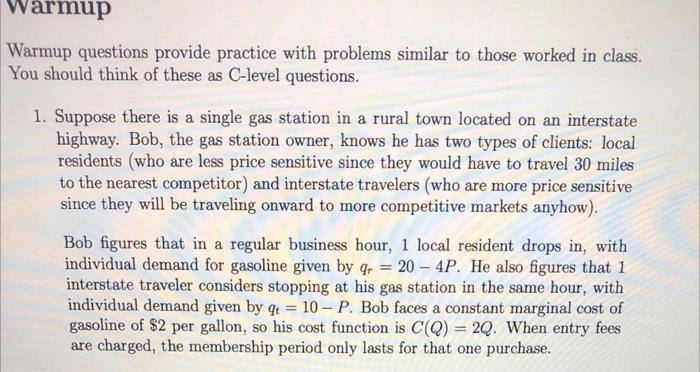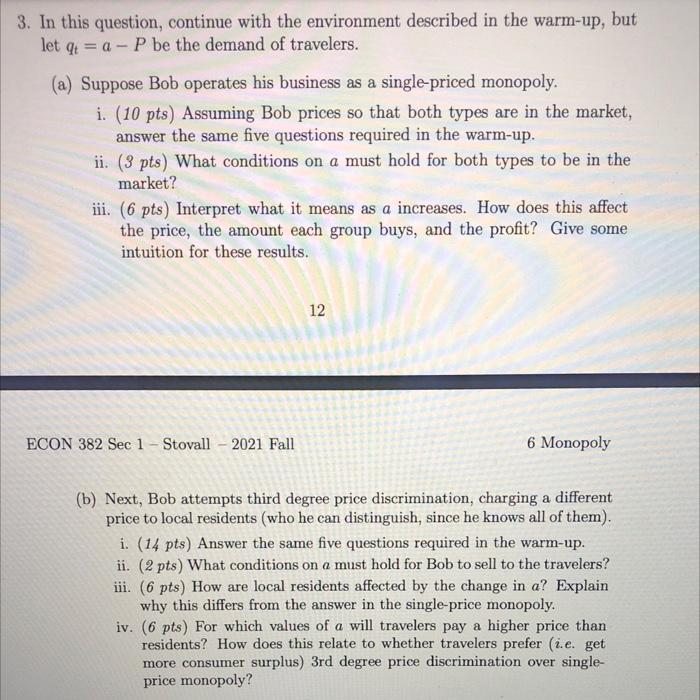Answered step by step
Verified Expert Solution
Question
1 Approved Answer
just need question 3 part b.) answered. the warmup is located in the first picture. thanks! Warmup Warmup questions provide practice with problems similar to
just need question 3 part b.) answered. the warmup is located in the first picture. thanks! 

Warmup Warmup questions provide practice with problems similar to those worked in class. You should think of these as C-level questions. 1. Suppose there is a single gas station in a rural town located on an interstate highway. Bob, the gas station owner, knows he has two types of clients: local residents (who are less price sensitive since they would have to travel 30 miles to the nearest competitor) and interstate travelers (who are more price sensitive since they will be traveling onward to more competitive markets anyhow). Bob figures that in a regular business hour, 1 local resident drops in, with individual demand for gasoline given by qr = 20 4P. He also figures that 1 interstate traveler considers stopping at his gas station in the same hour, with individual demand given by q= = 10 - P. Bob faces a constant marginal cost of gasoline of $2 per gallon, so his cost function is C(q) = 2Q. When entry fees are charged, the membership period only lasts for that one purchase. 3. In this question, continue with the environment described in the warm-up, but let qe = a - P be the demand of travelers. (a) Suppose Bob operates his business as a single-priced monopoly. i. (10 pts) Assuming Bob prices so that both types are in the market, answer the same five questions required in the warm-up. ii. (3 pts) What conditions on a must hold for both types to be in the market? iii. (6 pts) Interpret what it means as a increases. How does this affect the price, the amount each group buys, and the profit? Give some intuition for these results. 12 ECON 382 Sec 1 - Stovall - 2021 Fall 6 Monopoly (b) Next, Bob attempts third degree price discrimination, charging a different price to local residents (who he can distinguish, since he knows all of them). i. (14 pts) Answer the same five questions required in the warm-up. ii. (2 pts) What conditions on a must hold for Bob to sell to the travelers? ii. (6 pts) How are local residents affected by the change in a? Explain why this differs from the answer in the single-price monopoly. iv. (6 pts) For which values of a will travelers pay a higher price than residents? How does this relate to whether travelers prefer (i.e. get more consumer surplus) 3rd degree price discrimination over single- price monopoly? Warmup Warmup questions provide practice with problems similar to those worked in class. You should think of these as C-level questions. 1. Suppose there is a single gas station in a rural town located on an interstate highway. Bob, the gas station owner, knows he has two types of clients: local residents (who are less price sensitive since they would have to travel 30 miles to the nearest competitor) and interstate travelers (who are more price sensitive since they will be traveling onward to more competitive markets anyhow). Bob figures that in a regular business hour, 1 local resident drops in, with individual demand for gasoline given by qr = 20 4P. He also figures that 1 interstate traveler considers stopping at his gas station in the same hour, with individual demand given by q= = 10 - P. Bob faces a constant marginal cost of gasoline of $2 per gallon, so his cost function is C(q) = 2Q. When entry fees are charged, the membership period only lasts for that one purchase. 3. In this question, continue with the environment described in the warm-up, but let qe = a - P be the demand of travelers. (a) Suppose Bob operates his business as a single-priced monopoly. i. (10 pts) Assuming Bob prices so that both types are in the market, answer the same five questions required in the warm-up. ii. (3 pts) What conditions on a must hold for both types to be in the market? iii. (6 pts) Interpret what it means as a increases. How does this affect the price, the amount each group buys, and the profit? Give some intuition for these results. 12 ECON 382 Sec 1 - Stovall - 2021 Fall 6 Monopoly (b) Next, Bob attempts third degree price discrimination, charging a different price to local residents (who he can distinguish, since he knows all of them). i. (14 pts) Answer the same five questions required in the warm-up. ii. (2 pts) What conditions on a must hold for Bob to sell to the travelers? ii. (6 pts) How are local residents affected by the change in a? Explain why this differs from the answer in the single-price monopoly. iv. (6 pts) For which values of a will travelers pay a higher price than residents? How does this relate to whether travelers prefer (i.e. get more consumer surplus) 3rd degree price discrimination over single- price monopoly 

Step by Step Solution
There are 3 Steps involved in it
Step: 1

Get Instant Access to Expert-Tailored Solutions
See step-by-step solutions with expert insights and AI powered tools for academic success
Step: 2

Step: 3

Ace Your Homework with AI
Get the answers you need in no time with our AI-driven, step-by-step assistance
Get Started


